|
|
 |
Fiche d'espèce de Copépode |
|
|
Calanoida ( Ordre ) |
|
|
|
Arietelloidea ( Superfamille ) |
|
|
|
Augaptilidae ( Famille ) |
|
|
|
Frankferrarius ( Genre ) |
|
|
| |
Frankferrarius admirabilis Markhaseva, 2013 (F,M) | |
| | | | | | | Ref.: | | | Markhaseva, 2013 (p.1252, Def., figs.F,M, Rem.) | 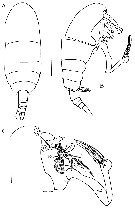 Issued from : E.L. Markhaseva in Crustaceana, 2013, 86 (10). [p.1254, Fig.1]. Female (from 14°59.41'S, 29°56.57'W): A-B, habitus (dorsal and lateral, respectively); C, cephalon (lateral). Scale bars = 1 mm (A, B); 0.5 mm (C). Nota: Prosome 3.1 times as long as urosome. labrum with soft appendage (sa) laterally. Paragnaths (prgn) distally bearing terminal small spine-like attenuations and located posterior to the mandible.
|
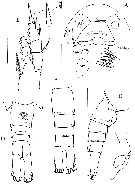 Issued from : E.L. Markhaseva in Crustaceana, 2013, 86 (10). [p.1255, Fig.2]. Female: A, cephalon (ventral); B, urosome (dorsal); C-D, posterior corner of prosome and urosome (lateral and ventral, respectively).
Scale bars = 0.5 mm.
|
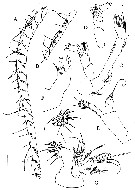 Issued from : E.L. Markhaseva in Crustaceana, 2013, 86 (10). [p.1256, Fig.3]. Female: A, A1 (segments I-XVIII (16th)); B, A1 (segments XIX (17th) to XXIII (21st)); C, A2; D, exopod of A2; E, Md (mandibular palp); F, Md (gnathobase); G, Mx1. Scale bar = 0.5 mm. Nota: A1 distal part broken, ancestral segment XXIII reaching anterior part of pediger 4. Md: gnathobase cutting edge wide, with 6 teeth and 1 seta; 2 teeth with bifid apices. Exopod of 5 segments (setal formula: 1, 1, 1, 1, and 2 setae). Mx1: praecoxal arthrite heavily sclerotized, large with 15 setae; coxal endite with 3 setae, coxal epipodite without setae; proximal basal endite with 2 setae; distal basal endite with 3 setae; endopod 1-segmented with 4 setae; exopod with 2 setae.
|
 Issued from : E.L. Markhaseva in Crustaceana, 2013, 86 (10). [p.1257, Fig.4]. Female: A, Mx2; B, distal part of basis and endopod segment 1 of Mx2; C, endopod segment 2 of Mx2; D, Mxp. Scale bar = 0.5 mm. Nota: Mx2: huge, strongly modified; praecoxa and basis of nearly equal length, more than 3 times as long as coxa; praecoxa with endite bearing 2 setae; very well-developed articulation between coxa and basis, coxa lacking endites; basis with 1 distal seta; endopod 2-segmented, segment 1 with 2 strong sclerotized setae; endopod setae tightly grouped together. Mxp: syncoxa and basis of nearly same size, without setae. Endopod 5-segmented (setal formula: 1, 2, 2, 1, and 4 setae).
|
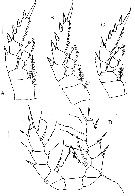 Issued from : E.L. Markhaseva in Crustaceana, 2013, 86 (10). [p.1259, Fig.5]. Female: A, P2; B, P3; C, P4; D, P5. Scale bar = 0.5 mm.
|
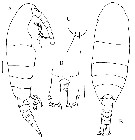 Issued from : E.L. Markhaseva in Crustaceana, 2013, 86 (10). [p.1260, Fig.6]. Male (14°58.9'S, 29°56.49'W: A-B, habitus (lateral and dorsal, respectively); C, forehead (ventral); D, caudal rami (dorsal). Scale bars = 1 mm (A, B); 0.5 mm (C, D). Nota: Prosome 5.5 times as long as urosome. Rostrum as in female. Labrum similar to female, but paragnathes are not as visible in lateral view and pair of small chitinous attenuations present posterior to Mx1. cephalosome and pediger 1 separate, pedigers 4 and 5 fused. Posterior corners of prosome as in female. Caudal rami as in female, but vestigial proximolateral seta I present. A2 identical to that of female, except for endopod segment 2 with 14 setae. Md, Mx1, Mx2, Mxp and P2-P4 identical to those of female.
|
 Issued from : E.L. Markhaseva in Crustaceana, 2013, 86 (10). [p.1261, Fig.7]. Male: A, left A1 (segments I-VII (6th)); B, left A1 (segments IX-XIII (11th)); C, left A1 (segments XIV-XVIII (16th)). Scale bar = 0.5 mm. Nota: A1 geniculate on left. Left and right A1 free segments 1 to 16 (ancestral I to XVIII). Left A1 segments XIX-XXI differ from those on right as geniculation present between segments XX and XXI. Some sensilla are short and sclerotized, other are long, poorly sclerotized and, probably, perform aesthetasc function.
|
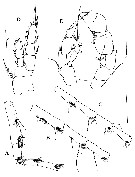 Issued from : E.L. Markhaseva in Crustaceana, 2013, 86 (10). [p.1262, Fig.8]. Male: A, left A1 (segments XIX-XXII (20th); B, right A1 (segments XIX-XXI (19th)); C, right A1 (segments XXII-XXV (23rd)); D, P1; E, P5. Nota: P1 as in female, except for lateral spine of exopod segment 2 which is shorter than in female, not exceeding base of proximal lateral spine of exopod segment 3. P5 biramous. Coxa without seta; basis with lateral seta; endopod segments 1 and 2 without setae, endopod segment 3 with 6 setae, right endopod 1-segmented with 1 seta. Left exopod segment 3 with 2 lateral spines. Right exopod segment 2 wider than left, with excavation on inner distal edge, excavation densely covered with thin spinules, segment 3 wider than left, with 1 lateral spine and scar marking insertion of broken setal element
Scale bar = 0.5 mm.
| | | | | NZ: | 2 | | |
|
Carte de distribution de Frankferrarius admirabilis par zones géographiques
|
| | | | Loc: | | | S Atlantic (Brazilian Basin), N Atlantic (W Canary Basin) | | | | N: | 1 | | | | Lg.: | | | (1141) F: 7,0; M: 11,2; {F: 7,0; M: 11,2} | | | | Rem.: | Above the sea bed (depth 5148 m, 5131 m, 4338 m), near-bottom samples collected with a closing epibenthic sledge (see Brandt & Barthel, 1995).
Markhaseva (2013, p.1260) underlines that males are commonly smaller than females, but, sometimes are larger. The possibility that the male might not be the same species as the female is considered [because the individuals are not exactly in the same locality and at the same date, but the number of individuals is too limited] | | | Dernière mise à jour : 21/02/2015 | |
|
|
 Toute utilisation de ce site pour une publication sera mentionnée avec la référence suivante : Toute utilisation de ce site pour une publication sera mentionnée avec la référence suivante :
Razouls C., Desreumaux N., Kouwenberg J. et de Bovée F., 2005-2025. - Biodiversité des Copépodes planctoniques marins (morphologie, répartition géographique et données biologiques). Sorbonne Université, CNRS. Disponible sur http://copepodes.obs-banyuls.fr [Accédé le 30 novembre 2025] © copyright 2005-2025 Sorbonne Université, CNRS
|
|
 |
 |











